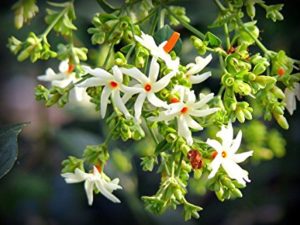The Parijat tree is considered to be a divine tree which blooms occasionally (usually after Ganga Dusshera) with flowers that are white on blooming and turn yellow on drying. The tree is unique in more than one aspect. It is a unisex tree which cannot be grown by plantation of its offshoots and it does not produce either its seeds or fruits. The leaves of the tree in the lower portion have five tips like the fingers of our hand and the upper portion having seven.

The flower from the tree is referred to as the Parijat flower and the perimeter of the trunk of this tree is around 50 feet and its height is close to 45 feet. The tree is believed to be more than 1000 years old.
The Parijat tree at Kintur village, Barabanki, Uttar Pradesh, India.
In Botany, the Parijat tree is named as Adansonia digitata, due to its resemblance to the Adansonia class of trees. This class has eight members with six being found in the African continent and the other two in the Arabian Peninsula and Australia respectively. Trees of this class reach heights upto 100 ft and their trunk diameters range from 23 to 36 ft. The other common name for Adansonia digitata is Baobab.
The Parijat tree is located in the Kintur village which is near Barabanki, a district about 30 km from the capital city of Lucknow, Uttar Pradesh, India. Kintur is about 38 km from Barabanki and was named after Kunti who was the mother of the Pandavas in the epic Mahabharata. There are several temples around the place and the tree is located near one such temple that was established by Kunti.
There are a number of legends associated with this tree. The common ones are listed below:
It is believed by some that the tree originated from the ashes of Kunti.
Some say that Arjun brought this tree from the heavens and Kunti used to offer its flowers to Lord Shiva.
It is also said that Lord Krishna stole a branch of this tree from Indra’s kingdom and brought it to the earth. The Parijat tree was planted in Indralok, being one of the many gifts from the Samudra Manthan. Narada brought some flowers from the tree and gave them to Lord Krishna. Lord Krishna gifted the flowers to his wife Rukmini. Narada told Satyabhama (Krishna’s other wife) about this and advised her to ask Krishna to get the Parijata tree from Indralok and plant it in her garden. Satyabhama did exactly that and in the meantime, Narada went back to Indralok and warned Indra that someone from the earth might attempt to steal the tree from Indralok. An angry Indra confronted Krishna while he was leaving with a branch of the tree. This led to a battle which Indra lost. However, he put forth a curse on the branch that it will never bear fruit even though it may produce flowers. Since then, the tree does not bear any fruit. Once Krishna brought the tree to Dwarka, another conflict arose between his two wives, with both insisting to have the plant in their respective gardens. So, Krishna planted the tree in such a manner that although it was planted in Satyabhama’s garden, its flowers would fall in Rukmini’s garden. In this way, Rukmini got the flowers and Satyabhama got the tree.
Painting showing Krishna uprooting a branch of the Parijata tree from Indralok I
In the Harivansh Puraan, the tree is referred to as a “KALP-VRAKSH”, or wish bearing tree which apart from this one can only be found in heaven. Newly-weds visit the tree for blessings and a fair is held every Tuesday when people worship the tree







